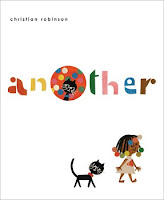How to Read a Wordless Book Out Loud
I have updated this piece over the last ten years. For all my reviews of wordless picture books, look for the label Stories without Words!
**As with any picture book you plan to read out loud, to an audience of one or one hundred, I strongly suggest reading it to yourself, alone, first. Pre-reading familiarizes you with the pace of the story, the characters (and any voice acting you might want to employ), the climax and the ending. Think of yourself as an actor reading your script before your performance!**
David Wiesner is undoubtedly the master of visual storytelling, having won the Caldecott Medal for Tuesday, The Three Pigs and Flotsam, as well as the Caldecott Honor Award for Free Fall and Sector 7. But, before we dive into the wordless works of David Wiesner, I want to introduce you to Barbara Lehman, author/illustrator of The Red Book, winner of the Caldecott Honor in 2005, as well as Museum Trip, Rainstorm, Trainstop and The Secret Box. Lehman and Wiesner both use watercolors to magnificently illustrate their books, but in very different ways. Lehman employs black outlines that give her pictures a two dimensional, almost comic book feel, making her books ideal for younger children who aren't quite ready to pore over the intricate details of Weisner's work. This isn't to say that her illustrations are simplistic. They are rich with details, crisp and colorful, and, most of all, inviting. Readers can't help but be drawn in to Lehman's books, especially The Red Book, which is about being drawn into a book, literally!
The plots of Lehman's books are often circular, ending where they began. The Red Book begins and ends with a nameless, red book stuck in a snowbank in a city somewhere. In between, the finder of the red book opens the pages to see another reader, on a sandy beach, who can see her, too. The story follows the city child as she devises a way to meet up with the other reader of the red book. Other than serving as a page turner, how can you "read" this book out loud, drawing younger children into the story and drawing out their imaginations? There are a few things you can do before you even open the book to begin engaging your audience. Whenever I read out loud, at home or at work, I like to say the name of the book and the name of the author and illustrator. After that, I usually open the book and start reading the story. However, with Lehman's books, which all have the main character on the cover, I like to tell my audience that we are going to read a book without words and I need help to tell this story. Then, I ask the audience to choose a name for the main character to get us started. Gender appropriate names, or even real names, don't matter. This is about what the audience sees, thinks and imagines. Reading a wordless book out loud requires a fine balance between audience involvement and verbal illustration enrichment on your part. As the "reader," take every opportunity to throw in adjectives when appropriate. Ask your audience to say how the main character is feeling based on his/her/their expression. Ask your audience what they think the main character is thinking. Use your narrative to frame input from the audience and move the story along, page by page - or follow the narrative created by listeners. As an solo reader, you know where your imagination goes as you read a wordless book to yourself. When reading out loud to an audience, you want to engage them and have them tell you where their imaginations are going as they look at the pictures in the book. All four of Lehman's books have main characters who are alone, and maybe lonely, but who find a connection with others, which reminds me a little bit of wordless picture books themselves - the pictures are out there on their own, waiting to connect with a reader who enrich the story with their own words.
 David Wiesner's books take imagination and illustration to the next level. Some of Wiesner's artwork would not be out of place hanging in a museum next to the works of Rene Magritte and Salvador Dali. Wiesner's books are more detailed and his plots more complex than Barbara Lehman's, making for even more reading opportunities, but also requiring a slightly more advanced ability to understand the unfolding stories. Of course, these stories don't need to be understood or explained to be enjoyed. Simply looking at the beautiful, painterly illustrations with your audience and talking about the minutiae can make for an entertaining experience. Without words, readers (and listeners) are forced to slow down and look more closely at the illustrations, for clues and for narrative, than they would when reading a picture book with words. Words provide the cues for what to think about the story and how to look at the illustrations - without them, interpretation is up to you. Reading a book without pictures is also great practice for future museum visits and appreciation of art that hangs on the wall rather than between the pages of a book. Because of the detailed nature of Wiesner's illustrations, naming all the characters in his books might not be the best strategy, especially for the intricate Flotsam. However, this could be great fun with the more playful Sector 7 in which clouds have personalities and Tuesday in which frogs on flying lily pads have a nocturnal adventure.
David Wiesner's books take imagination and illustration to the next level. Some of Wiesner's artwork would not be out of place hanging in a museum next to the works of Rene Magritte and Salvador Dali. Wiesner's books are more detailed and his plots more complex than Barbara Lehman's, making for even more reading opportunities, but also requiring a slightly more advanced ability to understand the unfolding stories. Of course, these stories don't need to be understood or explained to be enjoyed. Simply looking at the beautiful, painterly illustrations with your audience and talking about the minutiae can make for an entertaining experience. Without words, readers (and listeners) are forced to slow down and look more closely at the illustrations, for clues and for narrative, than they would when reading a picture book with words. Words provide the cues for what to think about the story and how to look at the illustrations - without them, interpretation is up to you. Reading a book without pictures is also great practice for future museum visits and appreciation of art that hangs on the wall rather than between the pages of a book. Because of the detailed nature of Wiesner's illustrations, naming all the characters in his books might not be the best strategy, especially for the intricate Flotsam. However, this could be great fun with the more playful Sector 7 in which clouds have personalities and Tuesday in which frogs on flying lily pads have a nocturnal adventure.
However you choose to frame your narrative, calling attention to details and involving the listener is key to an engaged experience when reading a book without words. The way in which you call attention to and narrate the details determines the level of imagination and attention that your listeners exhibit. I have always been the kind of reader who pores over illustrations and points out details. When my children were infants, this was a great strategy for engaging them in the story. While reading Goodnight Gorilla by Peggy Rathmann I would always point out the mouse with the banana, who is somewhere different on each page. Eventually, I could ask, "Where is the mouse?" and my audience would delight in showing me. Looking for details has its rewards as well, especially with author/illustrators like Peggy Rathmann, who hides characters from one book in the pages of another - see 10 Minutes till Bedtime, an almost wordless book with guest appearances by the stars of Caldecott Medal winner Officer Buckle and Gloria and the cast of Goodnight Gorilla. Readers of the works of David Shannon can have fun searching for his dog Fergus, a little, white terrier and star of his own book, Good Boy, Fergus, hidden within illustrations of all of his books. Shannon is very creative and he doesn't make the hunt easy. And, don't miss Fritz, the Bull Terrier from Chris Van Allsburg's first book, The Garden of Abdul Gasazi (1979), who went on to appear, sometimes as a character, sometimes as a teapot, in every picture book, including the non-fiction biography, Queen of the Falls.
However you choose to approach the experience, reading a wordless book out loud is both challenging and rewarding, for you and your audience. Getting good at it and appreciating it means looking at it like a muscle that needs flexing and developing. The more you work it, the more it works for you, and the more you get out of the wordless books you read. The ultimate gift of reading the wordless picture book out loud is the creativity it inspires in the listener. Wordless picture books are springboards to stories yet to be told, germinating in your children's minds.
A few other wordless picture books you
shouldn't miss (with links to reviews):
Aaron Becker's Journey Trilogy
The amazing Suzy Lee's Books
Molly Idle's Flora Trilogy
Mercer Mayer's Wordless Series (and my first encounter with wordless books as a child)
Don't forget about another favorite of mine, graphic novels, of which there are quite a few fantastic, wordless ones like these:
































































